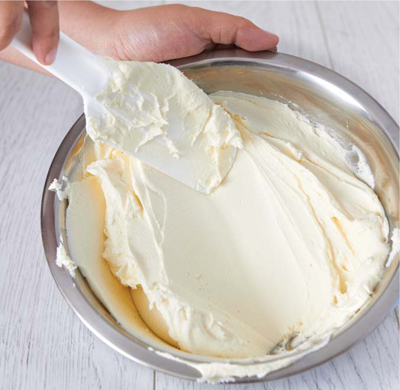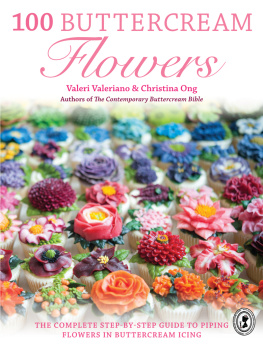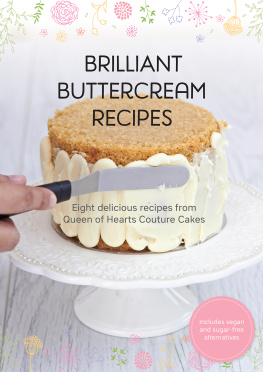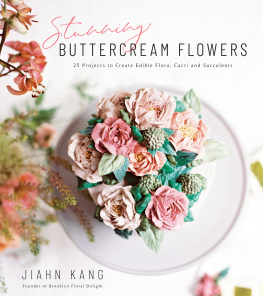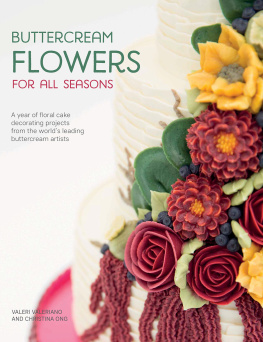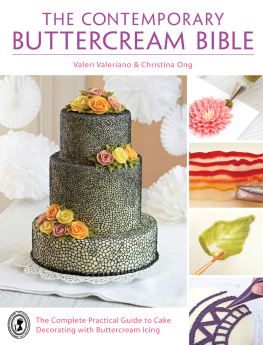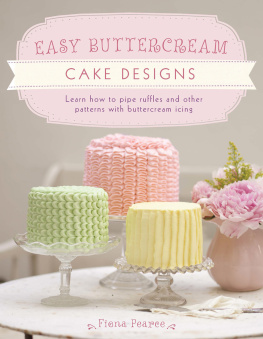Contents
Guide
BUTTERCREAM Flowers
Valeri Valeriano & Christina Ong
THE COMPLETE STEP-BY-STEP GUIDE TO PIPING FLOWERS IN BUTTERCREAM ICING
www.stitchcraftcreate.co.uk

CONTENTS
PROJECTS
Introduction
This book is like our cake journey. If you have read our first book, The Contemporary Buttercream Bible, you will remember our first ever buttercream encounter we piped a sunflower using a Ziploc bag as an improvised piping bag. The results were not great. But then we put clear tape around the end of the bag and cut a V shape for an instant nozzle, and a few moments after, Queen of Hearts Couture Cakes was founded! From that first 'beautiful' sunflower cupcake, we instantly became obsessed with piping. We learned how to pipe two more flowers then five... then eight.. and now, 100!
Our love of colour has made us treasure beautiful flowers as inspirations for planning our cake designs. A few years ago, we started our 'Flowers To Do List' as a prompt to try to learn how to pipe as many flowers as we could, but we never really thought that the day would come when we would reach our target of 100 flowers and fulfil our ambition to put them in a book. The flowers here are all inspired by real flowers. Despite the fact that there are specific nozzles to use for so many different effects, there have still been some limitations in achieving anatomically correct flowers. This though does not affect the beauty of all the edible masterpieces in this book.
Three years ago we were scared to work on anything bigger than a cupcake because we thought a full-sized cake would be too complicated, but as we practised we gained confidence and became brave enough to decorate a small cake, and now we're happy to tackle multi-tiered cakes. So we thought, in this book, we would also start small by decorating cupcakes, and by the end of it we hope that you too will find yourselves decorating towering cakes. We have also included five full-sized cake projects in this book, to show you how to apply your newly found piping skills on a bigger scale. Furthermore, we have showed how to pipe the flowers in clusters because this is a technique in itself. To pipe a single flower is easy, but to group them can be challenging so we've got this covered for you.

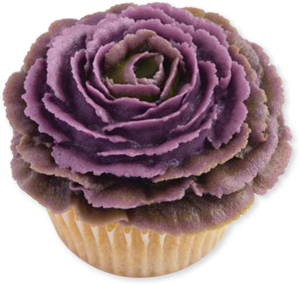
There are loads of nozzles available and ways to pipe different effects, but in this book we have tried to simplify things for you so even if you are a beginner, you only have to practise and master our , and you will be able to create all 100 flowers, and even more than that. When you have mastered the strokes, go ahead and explore other nozzles for variety, or try using bigger ones. You should also experiment with different brands of food colouring pastes and gels. Understanding colour mixing is very helpful when you want to achieve the right shades.
We hope that this book will inspire you to make not just one or two flowers, or even 100, but practise, practise and a little bit more practise is all you need!

Buttercream Basics
BASIC BUTTERCREAM RECIPE
With this recipe, the one thing you should remember is never over-beat your buttercream. If you do it will become grainy and the edges of your petals are likely to break when you pipe your flowers.
A hand-held mixer is not usually as powerful as a stand mixer, so if you are using a hand-held mixer, make sure you fold your mixture manually first until the ingredients are incorporated. This helps to avoid over-beating as well.
What is so good about our recipe is that a little less or more of a certain ingredient is fine. So if your buttercream is too stiff, add water or milk. If it is too thin, just add icing (confectioners) sugar. Adjust it as you need to all in moderation, of course. You may use your buttercream straight away to cover and decorate your cakes but we suggest you chill it in the fridge for about an hour for the best results.

ABOUT VEGETABLE FAT, AKA SHORTENING
This is a white solid fat made from vegetable oils, and is usually flavourless or at least bland. It plays a very important role in our recipe as it helps make our buttercream stable. It also allows the surface of the decorated cake to crust so that it is not too sticky. And since it makes it stable, you do not need to add too much icing sugar to make a stiff consistency, thus your frosting has just the right sweetness.
Different brands of vegetable fat (shortening) have different consistencies. If the consistency of your shortening is somewhat medium-soft to slightly hard, like Trex, use 113g (4oz) in the recipe below. If it is soft and very spreadable, like Crisco, you will have to double the amount to 227g (8oz).
You will need
- 227g (8oz) butter, room temperature
- 113g (4oz) medium soft vegetable fat (shortening) (Trex), at room temperature, OR 227g (8oz) of soft spreadable vegetable fat (Crisco)
- 23 tsp vanilla essence, or your choice of flavouring
- 1 tbsp water or milk (omit if you live in a hot country or whenever the temperature is hot)
- 600g (1lb 5oz) icing (confectioners) sugar, sifted, if you are using medium soft vegetable fat OR 750g (1lb 10oz) icing sugar, sifted, if you are using soft spreadable vegetable fat
- Mixer (hand-held or stand mixer)
- Mixing bowls
- Spatula
- Sieve (sifter/strainer)
- Measuring spoons
. Beat the butter at medium speed until soft and pale (about one to two minutes). Some brands of butter are more yellow in colour, so to make it paler you can increase the beating time to about two to five minutes.
. Add the vegetable fat (shortening) and beat for another 20 to 30 seconds or less. Make sure that it is well incorporated and that there are no lumps.
Important: As soon as you add anything to the butter, you must limit your beating time to 2030 seconds or even less.
. Add vanilla essence, or your flavour of choice and water, or milk, then beat at medium speed for about 10 to 20 seconds until well incorporated.
. Slowly add the sifted icing (confectioners) sugar and beat at medium speed for another 20 to 30 seconds or until everything is combined. You may want to fold the ingredients together manually before beating to avoid puffing clouds of sugar round your kitchen. Make sure you scrape the sides and bottom of your bowl, as well as the blade of your mixer, so you dont miss any lumps of icing sugar.
. Lastly, after scraping the bowl, beat again for about 20 to 30 seconds and do not over-mix. This yields a perfect piping consistency for buttercream.
